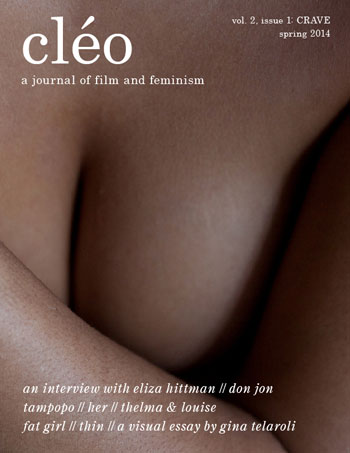The theme of the new issue of cléo, “a journal of film and film culture, informed by feminist perspectives,” is “crave,” and who better to present it than founding editor Kiva Reardon:
Julia Cooper interviewed Eliza Hittman, whose debut feature and anti-cumming-of-age story, It Felt Like Love, is finally getting the recognition it deserves. Eleni Deacon delves into internet porn, examining just what a modern Don Jon stands for. Mallory Andrews looks at eggs and abjection in Tampopo, and Angelo Muredda explores absentee bodies in Her. At long last, Thelma & Louise makes it into our digital pages, as Lindsay Jensen traces the routes the women take as they run from the law and toward a radical freedom. Zorianna Zurba boldly goes into the twisting and twisted cravings of Catherine Breillat’s Fat Girl, and I round things off with a foray into appetites as controlling forces in the eating disorder documentary Thin. And for the first time, we’re pleased to publish a visual essay, “Caught in the Frame,” by filmmaker and critic Gina Telaroli.
Gina Telaroli’s new visual essay in @cleojournal is mb her most expansive & gorgeous yet (& that’s saying something): http://t.co/2CwCrFHZLM
— C. Mason Wells (@cmasonwells) April 24, 2014
MORE READING
For the Los Angeles Review of Books, Michael Jauchen writes about All Movies Love the Moon, Gregory Robinson’s “spirited collection of prose poems about silent film… Each new page takes an individual movie and explores it centrifugally, letting its images echo and ping in the fleeting depths of the author’s own history. The overall effect is Eisensteinian, a stack of clashes forcing our attention toward the meanings that occur where Robinson’s discreet and radically different units collide.”
Grady Hendrix‘s new “Kaiju Shakedown” column focuses on Lau Kar-leung, who “forged the very soul of the kung fu film, and almost every martial-arts or action movie made since 1975 owes him a huge debt, from Ip Man to, believe it or not, Dirty Dancing.”
At the Dissolve, David Fear revisits “six films featuring past futures that cast light on their then-presents—former what-if predictors of the shape of things to come that double as time capsules.”
The BFI writes up “10 great British films directed by women.”
For the Guardian, Alex Godfrey has endured—but also evidently enjoyed—a typically lively interview with renowned cinematographer Christopher Doyle.
IN OTHER NEWS
MUBI’s Notebook is tumbling now, and it’s there that we learn that “American avant-garde filmmaker James Benning has generously uploaded 18 of his films to YouTube, including his most recent feature Stemple Pass.”
AGFA Indiegogo from Alamo Drafthouse.
“Led in part by Alamo Drafthouse co-founder Tim League, the [American Genre Film Archive] is looking to do something to make sure that the 35mm prints that the archive has gotten a hold of over the years—some of which may be the only copies in existence—can be given high-resolution 2K digital transfers,” reports Noel Murray at the Dissolve. “Recently, directors Paul Thomas Anderson and Nicolas Winding Refn joined the AGFA advisory board, which is currently pushing an Indiegogo campaign to digitize Craig Denney’s little-seen, reportedly super-strange 1975 science-fiction film The Astrologer.”
I’ll catch up with updating the entry on this year’s Tribeca Film Festival soon, but for now, let’s note that last night Talya Lavie’s Zero Motivation, a comedy about a unit of young Israeli soldiers, nabbed two prizes, including one for best narrative feature.” Gordon Cox has the full list of awards at Variety.
DVD/BLU-RAY
Riot in Cell Block 11 (1954) is “a rousing mid-’50s B movie with a thoroughly American topicality,” writes Jordan Cronk. Don Siegel “may have had only a handful of credits to his name prior to making the film, but it’s now all but understood that Riot in Cell Block 11 not only set the thematic template for his career, but also solidified an efficient aesthetic model which the director would spend decades reviving and recalibrating.”
David Bordwell on Dreyer‘s Master of the House (1925)
Also at Slant, Charles Laughton‘s The Night of the Hunter (1955) “is so loaded with neurotic symbology that it can accommodate nearly any meaning any generation wishes to assign to it, and that’s the source of its uneasy, primordial power,” writes Chuck Bowen.
For news and tips throughout the day every day, follow @KeyframeDaily. Get Keyframe Daily in your inbox by signing in at fandor.com/daily.




